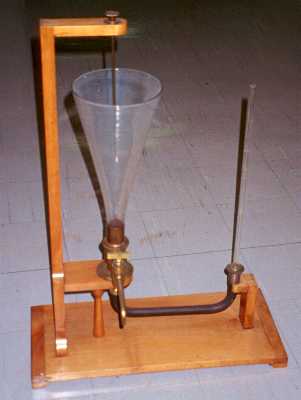| The version of the liquid-level vase at the right is sometimes
called Haldat's Apparatus. The apparatus at the right very closely follows
an illustration in the 1875 edition of Ganot's Physics. The accompanying
quote is: "It consists of a bent tube [on the bottom] at one end of which
is fitted a stopcock, in which can be screwed two vessels, of the same
height, but different in shape and capacity, the first being conical and
the second nearly cylindrical. Mercury is poured into the [horizontal]
tube until its level nearly reaches [the top of the upward bend of the
tube]. The [conical] vessel is then screwed on and filled with water. The
pressure of the water acting on the mercury causes it to rise in the cylindrical
tube, and its height may be marked with a small collar which slides up
and down the tube. The height of the water in [the conical vessel] is also
marked. When this is done, [the conical vessel] is emptied by means of
the stopcock [seen projecting toward the viewer], unscrewed and replaced
by [a vessel of a different shape]. When water is now poured into this,
the mercury, which had resumed its original level in [the horizontal tube]
rises in the cylindrical tube, and when the water in the [new vessel] has
the same height as it had [before], ... the mercury will have risen to
the height it had before. ... Hence the pressure on the mercury in both
cases is the same. This pressure is therefore independent of the shape
of the vessels, and, consequently, also of the quantity of liquid." |
 |